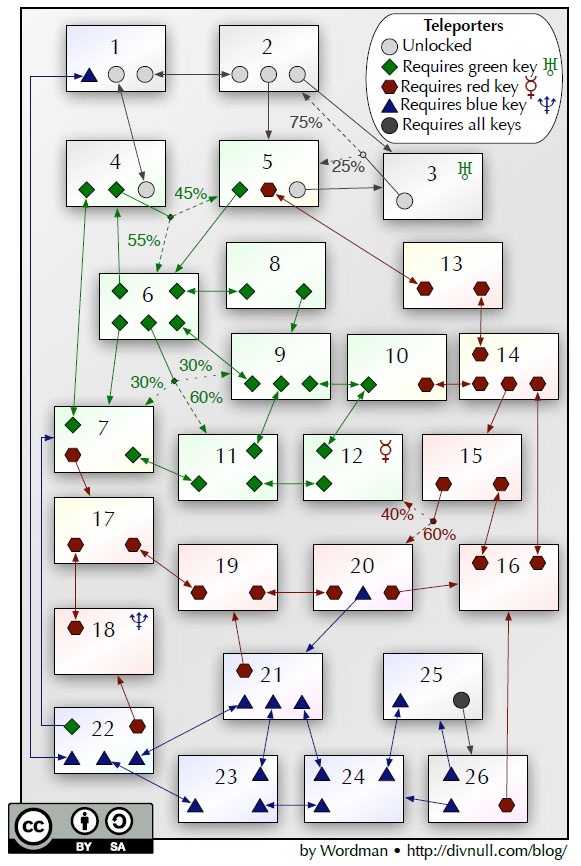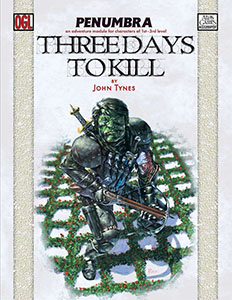LABORATORY #8: THE MILLSTONE
Large chamber, shaped like two ovals laid in a cross. The walls are scorched from a massive explosion; jagged bits of metal have actually been driven into the walls at frequent intervals. A skeleton in tattered robes lies nearby.
MILLSTONE: In the center of the chamber a large, beruned millstone grinds a deep channel into a floating moebius strip of stone.
- Madness of the Millstone: 1d8+2 rounds after entering this chamber, characters must make a Will save (DC 15) or suffer 1d3 points of Wisdom damage. As Wisdom damage is suffered, the runes on the millstone will begin to glow faintly blue and the millstone itself speeds up.
- The save is repeated every (10 rounds – 1 per 5 points of total Wisdom damage the millstone has inflicted).
DAMAGED TELEPORTALS: A blue teleportal and red teleportal have both been cracked and damaged by the explosion. Attempting to use them causes 6d6 damage (Fort save DC 22 for half damage) and the character is returned to the same location.
GREEN TELEPORTALS: These have not been damaged (lying at opposite ends of one of the crossing ovals).
DIRE ETHEREAL MARAUDERS: 3 dire ethereal marauders were drawn here by the explosion (or perhaps caused it). They have been transformed into hulking monstrosities by the burning of the Ethereal Plane.
ETHEREAL PLANE: The ethereal plane around this room burns as a result of the arcane explosion. Anyone traveling on the ethereal plane suffers 1d6 points of fire damage each round.
DIRE ETHEREAL MARAUDER (CR 5) – Large Magical Beast (Extraplanar)
DETECTION – darkvision 60 ft., Listen +8, Spot +6; Init +5; Languages —
DEFENSES – AC 18 (+1 Dex, +7 natural), touch 11, flat-footed 17; hp 43 (5d10+15)
ACTIONS – Spd 50 ft.; Melee Bite +13 (1d6+9); Ranged +6; Base Atk +5; Grapple +9
SQ darkvision 60 ft., ethereal jaunt
STR 26, DEX 12, CON 16, INT 7, WIS 12, CHA 10
FORT +13, REF +11, WILL +6
FEATS: Alertness, Improved Initiative, Weapon Focus (Bite)
SKILLS: Listen +8, Move Silently +6, Spot +6Ethereal Jaunt (Su): Shift from Ethereal Plane to Material Plane as free action; shift back as move action (per ethereal jaunt, caster level 15th).
*Skills: +2 racial bonus on Listen, Move Silently, and Spot checks.
LABORATORY #9: DEMON’S LABORATORY
Six niches in the wall have hand-shaped depressions next to them. Three of the niches are occupied by large ogres — apparently unconscious — with a silver band across each of their chests holding them upright.
In the center of the chamber there is a large, glass ovoid filled with a viscous green fluid. Floating within the fluid is a spongy-skinned, humanoid creature glistening a gelatinous blue. Strange apparati surround the ovoid.
NICHES: The silver bands induce unconsciousness on anyone in the niche when they extend (Fortitude DC 30 negates). Putting a hand to the hand-shaped depressions causes the bands to retract or extend.
OVOID: The creature within the ovoid was formerly an ogre. He has been transformed into a painshrieker by the demon lairing in Laboratory #11.
- The creature will thrash and appear to be asking for release. Some blood will ooze from its mouth into the fluid surrounding it.
- Alchemy / Arcana (DC 11): Most of the mechanisms around the ovoid are based around carefully maintaining the balance of alchemical admixtures.
- Alchemy / Arcana (DC 21): To identify the cellular-destabilizing compounds being used.
PAINSHRIEKER (CR 8) – 89 hp (11d8+40), AC 20, handscythes +14/+14 (2d8+4), Save +11, Ability DC 18
Str 12, Dex 15, Con 16, Int 14, Wis 10, Cha 8
Skills: Hide +16, Listen +14, Move Silently +16, Search +16, Spot +14
Blindsight 30 ft. (high-frequency shrieks)
DR 10/silver
Painshriek (Su): 60 ft. cone once every 1d4 rounds. 2d6 first round; 4d6 second round; 6d6 third round.
LABORATORY #10: ARBORETUM GROTTO
A thick, tiered cleft. Magical lights clinging to the ceiling seem to cast daylight down onto the thick pleats of overgrowth choking the miniature vale.
TELEPORTALS: Green teleportal is at one end of the grotto. Red teleportal at the other end.
SPINDERS (x8): Roam through the overgrowth. Spinders are demonic vermin: Vaguely insectoid in appearance — but with a spongy skin rather than any sort of carapace — their broad, flat backs and upper portions of their crouched limbs are covered in thin, razor-sharp spines.
STATUE OF LIGHT: In the middle of the grotto sits a squat statue of clay clasping a bowl which seems lit from within.
- Liquid Light: The bowl is filled with liquid light. Anyone touching the liquid will cause it to flow up over their hand (or hands). From that point forward, their hands will glow white — producing the effects of a daylight spell.
ALCHEMY (DC 25): Recognizes that most of the plants growing here are actually valuable alchemical ingredients. Six hours of harvesting could yield 5,000 gp worth of raw ingredients.
SPINDER (CR 4) – LE Medium Outsider
DETECTION – Listen +7, Spot -1; Init +7; Languages telepathy
DEFENSES – AC 17 (+3 Dex, +4 natural), touch 13, flat-footed 14; hp 32 (5d8+10); Immune fire, poison; Resist acid 10, cold 10
ACTIONS – Spd 40 ft.; Melee bite +6 (2d6+1) and 2 claws +1 (1d4); Ranged +8; Base Atk +4; Grapple +6; Atk Options impregnating bite; SA summon
SQ telepathy
STR 13, DEX 16, CON 14, INT 6, WIS 8, CHA 6
FORT +6, REF +7, WILL +3
FEATS: Dodge, Improved Initiative
SKILLS: Hide +6, Listen +7, Move Silently +6, Search +6, Spot +7Pounce (Ex): Make a full attack in first round, even it has already taken a move action.
Improved Grab (Ex): Start grapple as free action if both claw attacks hit, no attack of opportunity.
Impregnating Bite (Ex): Bitten creature must make a Fort save (DC 15) or become impregnated with a spinder egg. Eggs attach to heart, whereupon larvel spinders hatch and begin feeding. After 1 hour, victim suffers a -5 penalty to all ability scores. After 90 minutes, victim suffers -10 penalty to all ability scores. After 2 hours, larval spinders eat through the wall of the heart (resulting in death). After 1 day, 2d6 spinders eat their way out of the body. Spinder eggs/larva can be treated with a remove disease spell.
LABORATORY #11: ROOM OF RED PISTONS
An expansive room filled with thick pistons of glowing red crystal running between floor and ceiling.
TELEPORTALS: All located in the center of the chamber.
- Spot (DC 15): To notice that they’re glowing more brightly than similar teleportals in other chambers.
DEMON: A glabrezu lairs here. It possesses a GREEN KEY.
CRYSTALLINE PISTONS: The pistons are creating massive magical energy through a churning of the Ethereal Plane. The room has an overwhelming magical aura.
- Breaking Pistons: If twelve pistons are broken, the teleportal network destabilizes and shuts down. None of the teleportals will work, but this also means that the teleport redirect effect in Tethe laboratories shuts down.
LABORATORY #12: CHAMBER OF WHISPERING WINDS
The two green teleportal rings are on either end of a long hall with a dozen pedestals to either side. One top of each pedestal stands a bottle.
24 BOTTLES:
- 8 have been broken.
- 1 contains a RED KEY.
- 1 is an efreeti bottle.
- 6 are empty.
- 2 contain haunting winds. (Use stats for greater shadows, but they take the form of a spectral, skeletal fog.)
- 1 acts as a greater pipes of haunting. (Those within 30 feet who hear the tune must succeed at a Will save (DC 18) or become frightened for 4 rounds. Those with less than 6 HD are panicked. Can be used twice per day.)
- 1 contains the sounds from an ancient field of battle: Clashing swords. Cries of pain. (Those succeeding at a Listen check (DC 20) can also pick out the faint sound of weeping behind all of it.)
- 4 contain whispering wind messages trapped from long ago (see below).
WHISPERING WIND #1 – ELDERLY MAN: “Beware the Brotherhood of the Blue Hand. They may have obtained a red key. If they can breach the laboratories, they may reach the sanctums.”
WHISPERING WIND #2 – YOUNG WOMAN: “Love me forever, Isidora, and I shall lay before thee the windswept thrones of kingdoms, the jewels of Cassara, and your heart’s desire.”
WHISPERING WIND #3 – GUTTURAL VOICE: “Take the branding irons from beneath the silver serpent. They must not fall into the hands of Posserak.”
WHISPERING WIND #4 – RASPY VOICE: “The wyrm Cassandra has betrayed us. Sargas stole the blue key from her, but those chambers are lost to us. Use not the blue keys.”
LABORATORY #13: THE LAVA MINES
The teleportal from Laboratory #5 is on a high ledge above a roiling lava flow. Above the lava flow is suspended a brass orb.
The teleportal from Laboratory #14 goes inside the brass orb. Mechanisms within the orb allow one to lower it down towards the lava and extract a hot lava core into a containment cylinder.
LABORATORY #14: SOUL BINDING LABORATORY
A rosette-shaped chamber. There’s a large apparatus in the middle of the room, roughly shaped like a curved starfish. In the center of this apparatus is a cylindrical depression about 5 feet deep. Four glass coffins are attached to the apparatus and extend away from it. One wall of the room bulges out into a semi-oval with white walls covered in blackened runes.
CYLINDRICAL DEPRESSION: A lava core from Laboratory #13 can be slid into it. If this happens, the apparatus powers up for 1d6 hours.
GLASS COFFINS – SEARCH (DC 20): A large black opal worth 500 gp is concealed within the mechanisms surrounding the head of one of the glass coffins. Twin diamonds worth 750 gp each are concealed in two others. The fourth coffin has a hollow, but no gemstone.
- Black Opal Coffin: If someone is placed within it and the coffin closed, it acts as a magic jar spell (capturing the soul in the black opal). If the coffin is opened and then closed, the soul will transfer back to the body in the coffin (even if it isn’t the original body). If the black opal is removed, the person in the coffin must make a Fortitude save (DC 22) or suffer 10d6 points of damage as the soul is ripped from their body and then reflected back.
- Diamond Coffins: If people are in both coffins and the lids are closed, there is a 50% chance of a permanent shield other connection being forged (determine the direction of the damage shift randomly) and a 50% chance that both characters will suffer the full damage suffered by either.
- No Gemstone Coffin: Malfunctioning from age. If activated (person in coffin; lid closed) an instant crystalline growth will fetter and crust over the coffin. Crystal had adamantine hardness. 15 minutes of air inside. Break DC 26; hardness 20; 320 hp.
BLACKENED RUNES – ARCANA/SPELLCRAFT (DC 22): To identify the rudimentary efforts of someone attempting to perfect the magic jar spell. It appears to be depending on some sort of technomantic loop, however.
GM Background: This was a high-powered laboratory (using the lava cores from Laboratory #13) that would often shift functions. It just happened to be investigating soul-binding at the time the complex was abandoned. This is, in fact, where the earliest instances of the magic jar spell were developed.
Go to Part 5: Laboratories #15-19
Any material in this post not indicated as Product Identity in the Open Gaming License is released by Creative Common Attribution-Share Alike 3.0.


















